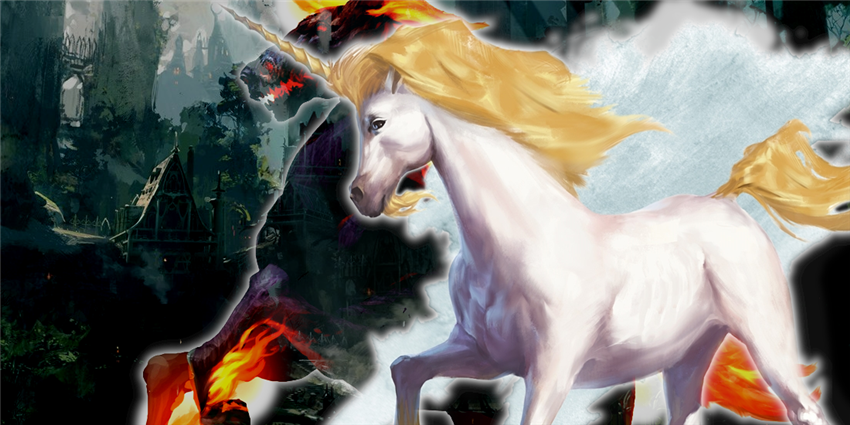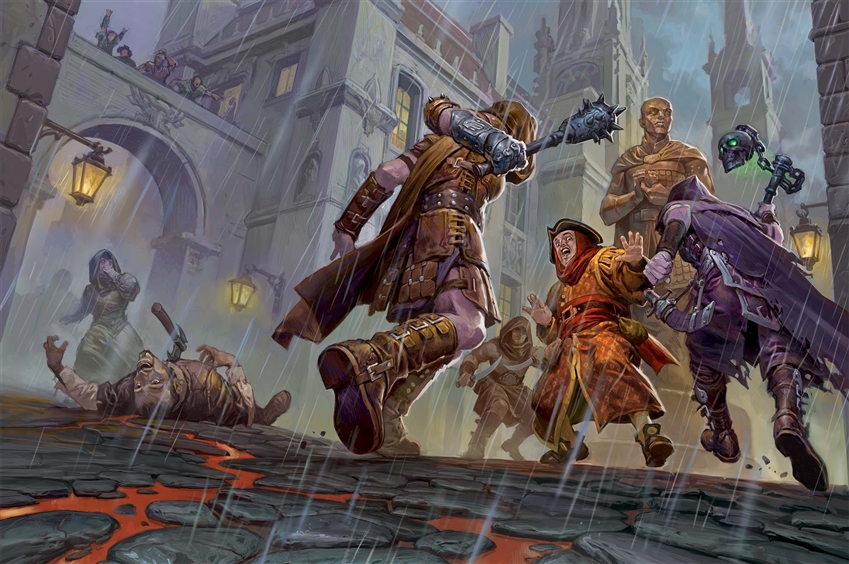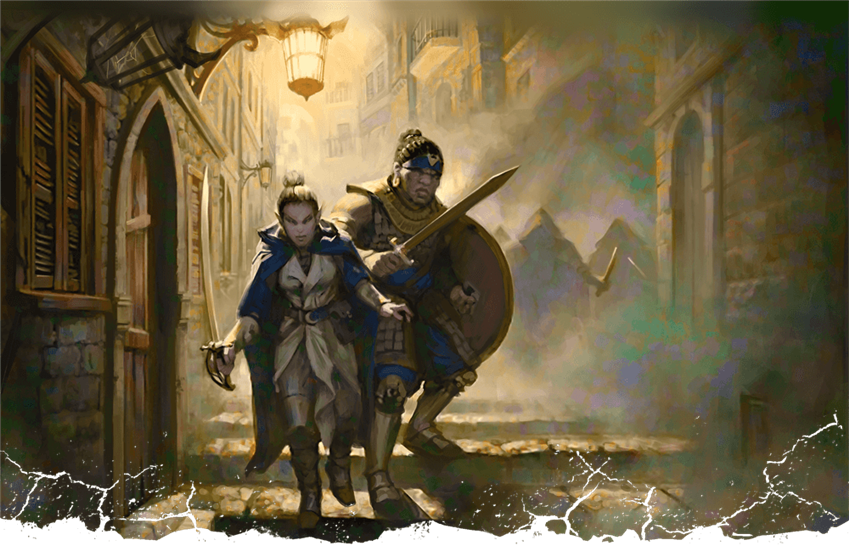Take a second to think about some of the most memorable chase scenes in cinema.
Hardboiled cop Popeye Doyle in The French Connection, weaving in and out of traffic in a madcap race to catch a train. James Bond, climbing a construction site in Casino Royale as his prey makes death-defying leaps across scaffolding. Indy and his friends in Indiana Jones and the Temple of Doom, piloting a mine cart as they flee from Thuggee pursuers.
Chase scenes remain in a viewer’s head forever. And with some planning, any Dungeon Master can create the same nail-biting moments in a game of Dungeons & Dragons, delivering just as many thrills as a combat encounter when done well.

The Rules of the Chase
Chase rules are located in Chapter 8 of the Dungeon Master’s Guide. Here are the most important points:
- Chases require a quarry and at least one pursuer, and in some instances, the pursuer can become the quarry. (For instance, if you’re running after a thief in a market and guards suddenly arrive, assume you’re the thief, and run after YOU instead.)
- The quarry should start the chase some distance ahead of the pursuer.
- Once that distance is determined, have all parties roll for initiative, but keep in mind that players are only allowed one action and one move. Bonus actions and reactions are not permitted, likely to streamline the chase and keep classes with high movement capabilities from catching the quarry too soon.
- Chase participants can freely use the Dash action 3 times plus their Constitution modifier. For every usage of Dash afterward, they must pass a DC 10 Constitution check or gain a level of exhaustion. Once they hit exhaustion level 5 and their speed drops to 0, they fall out of the chase.
- Every chase participant rolls a d20 at the end of their turn to see if complications occur. Complications are the bread and butter of D&D chases, and the Dungeon Master’s Guide presents two tables to consult from - Urban Chase Complications and Wilderness Chase Complications. More on those later, but one vital tidbit to remember: Complications affect the NEXT creature in the initiative order, not the one who just made their roll!
- Chases can end in a few ways: 1) When the quarry or pursuer drop from exhaustion, 2) When the pursuer catches up to the quarry, perhaps initiating normal combat rules, 3) When the quarry succeeds on a Dexterity (Stealth) check at the end of a round to hide (assuming they’ve escaped the pursuer’s sight), and my favorite, 4) When you, the DM, decide to call it!
Keeping these rules in mind, one thing is clear - a chase should be treated as a deliberate activity - a D&D mini-game - and there needs to be a clear delineation on the DM’s part to state: “Okay, now we’re in a chase scene. Your main goal is not to incapacitate this opponent, but to catch them.”

The Design of the Chase
Because chase rules are quite separate from normal D&D gameplay, I’ve found it best to only use them for critical story moments when you, as a DM, absolutely know that a chase is going to occur. Sure, you could also utilize them during a random battle when your players want to nab that fleeing bugbear, but I prefer my chases to be bold set pieces - for instance, a dash across the castle’s parapets in order to catch the assassin who’s poisoned the king!
Once the story impetus has been decided, consider whether you’ll run the chase as a Theater of the Mind exercise or on a tactical grid. Theater of the Mind may be easier since chases cover large distances and battle maps tend to make players think in terms of D&D’s normal movement rules, which are intended for small skirmishes where one square generally equals five feet. Or, if you’re playing virtually, using D&D Beyond’s shared dice rolling feature can keep everyone involved in watching the tension unfold.
Next, determine if your chase is an on-foot affair or if other forms of transportation will be involved. The rules assume that chase participants will be running, but you could put everyone on warhorses or even elephants simply by looking up the stat blocks on D&D Beyond. You could even use the stats of these mounts to represent vehicles that don’t have readily available stat blocks, which is a handy DM hack I’ve often used in the past.
Finally, when you’re running the chase itself, judiciously throw unpredictable hurdles at both the pursuers and the quarry at the end of each turn. The Chase Complications tables in the Dungeon Master’s Guide offer up great examples, like a stained glass window players have to jump through in an urban chase, or a swarm of insects that might collide with the party during a wilderness chase. I’d recommend tweaking these tables as appropriate for your campaign, since they barely scratch the surface of possibilities in more varied settings - for instance, snowy mountaintops. (Imagine a squad of feverish Chardlyn Berserkers chasing the heroes across an icy bridge in Icewind Dale: Rime of the Frostmaiden!)
Be aware that both tables in the Dungeon Master’s Guide state that d20 rolls of 11-20 lead to no complication. If you’d rather have no lulls in the action, try creating your own complications for these rolls. For example, in my Ghosts of Saltmarsh game, I had rolls from 11-15 result in chase participants crashing into important NPCs. One of my players rolled a 13, barrelled through the window of a Saltmarsh public bathroom, and came face to face with Oceanus, the sea elf she’d rescued ages ago from pirates. A hilarious moment was had by all - and then Oceanus joined the pursuit!
Lastly, chases are an incredible opportunity to flex your DM narration skills. A pursuer doesn’t just jump through that stained glass window - they catapult themselves into it like Batman, dozens of shards ripping their cloak as they somersault forward, barely getting up in time to catch a glimpse of their quarry’s feet darting down an alleyway to their right. That insect swarm doesn’t just make an attack of opportunity on the prey running past it - they lash out with their stingers in a dissonant symphony of frenzied buzzing. Amp up the colorful language, aim to recreate a film feel, and watch as the chase ends up leaving a deep impression on your players, just like the opening of Casino Royale.

The Thrill of the Chase
For a good chase template, look no further than Chapter 4 of Waterdeep: Dragon Heist, which features both street and rooftop chases. Personally, I’ll never forget the moment in this campaign when my rogue parkoured across Waterdeep’s chimneys trying to catch three-spined devils. The player before me rolled a 7 on the scene’s Rooftop Chase Complications table, and my DM said that the flagpole of Waterdeep’s Kara-Tur embassy was coming my way, threatening to slow me down.
Luckily, I made my DC 15 Dexterity saving throw - rolled a natural 20, in fact - and swung around the flagpole three times, cartwheeling into the air and nimbly joining my comrade as we lashed a flurry of daggers out at our foes.
That moment, I really felt the thrill of the chase - and the movie in my head was just as good as any I’d seen on screen.
Add some wild chases to your crazy mysteries and preorder Candlekeep Mysteries!
Jeremy Blum (@PixelGrotto) is a journalist, gaming blogger, comic book aficionado and fan of all forms of storytelling who rolled his first polyhedral dice while living in Hong Kong in 2017. Since then, he's never looked back, and loves roleplaying games for the chance to tell the tales that have been swirling in his head since childhood.








-
View User Profile
-
Send Message
Posted Feb 20, 2021exhaustion seems to be a great idea but the recovery time for someone who falls out of the chase is 5 long rests? I might have missed something but that 5 days to recover from running out of breath chasing someone seems a bit unrealistic.
-
View User Profile
-
Send Message
Posted Feb 20, 2021I can't disagree more with this statement.
-
View User Profile
-
Send Message
Posted Feb 20, 2021Please expand especially on where we can read those articles you mentioned.
Would make an interesting counterpoint to the article thus given more alternatives which is what I assumed the article was actually about.
-
View User Profile
-
Send Message
Posted Feb 20, 2021I like the idea of a chase in which the players are the quarry, all on warhorses and desperately trying to escape an enemy army and reach a fort before they are overtaken. Complications would be things like running into an advance scout who attacks, archers raining a hail of arrows down, or pits and potholes catching up horses. The very fort could be an obstacle as you have to make an on-the-fly Charisma check to get the guards to open the gates for you. You would need to make some on-the-fly stats for "the horde", which makes attacks on players that are too close to it or in the midst of it. I especially like this idea because the players need no notification not to fight. They likely understand that an entire army is out of their league.
-
View User Profile
-
Send Message
Posted Feb 20, 2021You're right!
Everyone plays in the way they want, but personally I don't like the line of thought that sees this game as a sequence of 'gameplay' moments.
For simplicity purposes adventures have encounters structured in combat, exploration, and social encounters. But when I tried to understand how to run better games for my players I realized that I needed to improve the pacing of my games, by removing all sorts of barriers and unnecessary rules (and the distinction between the 3 aforementioned encounter types). Instead of 15 athletic rolls to add and remove 10ft in a chase, give stronger feedback on players actions. This also means let players free to go in and out of combat, chase, cut useless scenes and present the player with the next meaningful choice. There's no real combat minigame, rolling initiative just means slowing down time, you can do it during a chase, under a ticking clock, or else. There's no need to fight till death, someone can easily fight while chasing an objective, switch to a social encounter anytime when tides turn. Dnd for me works best when it's not a series of 'minigames', but a fluid narration. It worked wonders for me at least.
Other stuff that worked great too:
- Build better encounters by clarifying to myself what are the stakes of the encounter, how am I going to raise the tension, how to cut it short when becomes boring because there are no questions to answer left. I reduced the amount of useless NPCs with no plot relevance. I stopped having useless random encounters (especially combats) that meant nothing and took time.
- I stopped using battle maps, or use them only when necessary (complex terrain or complex mechanisms). It limits players' imagination to only what they see there and limits their ranged options/avoiding the obstacle in other ways/etc. When I started DMing I thought I needed them for every encounter, but now I realized I was wrong.
I don't think I can link external content in here? Not sure but if you google "The Angry GM" (I checked it, didn't remember the exact name) you'll get it first result. His articles are way too long-winded, but I found tons of great points in there. I am glad people with a lot of experience like him can take the time to write down how to improve my sessions.
And anyway, I am happy dndbeyond finally has articles again! I just didn't align much with this one.
-
View User Profile
-
Send Message
Posted Feb 20, 2021By the way, SO GLAD we have real articles again! This is a major source of ideas for me as a player and DM, and I don't really have the time to listen to the Todd Talks.
-
View User Profile
-
Send Message
Posted Feb 20, 2021I think these are valid points, and pacing in a D&D game is also something I try to pay a lot of attention to! Not a fan of random battles either.
For this article, I obviously wanted to delve into the official chase rules, and since many of the more common activities in D&D (combat, hexcrawls) already could be considered "mini-games" in their own right, I see chases as an extension of that same logic. Nevertheless, I appreciate you reading this piece - hopefully my next one will be more to your liking!
-
View User Profile
-
Send Message
Posted Feb 21, 2021This is already better and more useful than any article I've ever read on this site. Well written and good examples.
I actually might start reading Dndbeyond articles now.
-
View User Profile
-
Send Message
Posted Feb 21, 2021Great article!
The chase is just one way the DM can up the intensity of an encounter and serves as a great template for having events involving skill checks and complications.
Looking forward to more great articles!
-
View User Profile
-
Send Message
Posted Feb 21, 2021Lot of anti-player sentiment in this thread.
-
View User Profile
-
Send Message
Posted Feb 22, 2021I'm in the hardcore camp concerning chases. A creature with a greater speed will outrun/catch a slower creature. However, I can appreciate the dramatic (Comedic) aspect of a chase. Personally I feel it makes an encounter too long, but that's just me.
-
View User Profile
-
Send Message
Posted Feb 22, 2021Don’t allow Bonus Actions or Reactions? This rule seems to punish Monks most who rarely have moments to shine over Fighters now that they can’t use Step of the Wind but a Fighter could still use Action Surge to double dash. Rogues can also BA dash and Vengeance Paladins might use their Reaction ability Relentless Avenger.
-
View User Profile
-
Send Message
Posted Feb 22, 2021Personally, I'd allow my players to use all of their features whenever it would be applicable. Orcs are relentless chasers, but aren't so adept at being the ones chased. Monks and rogues, along with spellcasters with expeditious retreat, ought to be allowed to use their features as that's the sort of scenario they're intended for. Leaping from building to building using things like jump and feather fall also come to mind.
-
View User Profile
-
Send Message
Posted Feb 22, 2021That is because when you are great with a hammer everything looks like a nail. Also, that applies in the real world. Police don't just drive after crooks, they attempt to shoot out the driver or the tires.
-
View User Profile
-
Send Message
Posted Feb 22, 2021I agree with microft22, causing problems for the players just because you are too lazy to adapt the scenario is stupid. I get it is prepublished but how hard is it to have a kenku throw sand in one of their eyes temporarily taking them out of the fight? It isn't. What would you think if I said barbarians shouldn't be able to rage in combat, you would think that is stupid and it is, just like your "idea" of preventing the party from using what they have. And they aren't different, a huge part of being a rogue is being fast, while a huge part of being a barbarian is raging.
-
View User Profile
-
Send Message
Posted Feb 22, 2021*Dabs*
-
View User Profile
-
Send Message
Posted Feb 22, 2021The exhaustion gained from chases seems to have a different recovery time than a regular level of exhaustion. From the DMG:
As I read it, after taking a rest of any length you remove ALL the levels that you gained from the chase.
-
View User Profile
-
Send Message
Posted Feb 23, 2021Hello Jeremy! Cool article, looking forward to more content
-
View User Profile
-
Send Message
Posted Feb 23, 2021@blummer102 and Mebi
So one thing that Mebi is saying - and I was gonna say the same thing - is that decision points matter. If a combat, chase, social interaction, or whatever doesn't have a few different (viable) options for players to choose from, then there aren't really any decisions to make, which is (often) unsatisfying and unchallenging. The scene might still be fun from, say, a narrative perspective, but if player decisions don't matter, the whole thing is basically running on autopilot.
Wouldn't you agree, Jeremy?
In re-reading this chase article, it seems focused on being engaging through *narrative.* Which is one way of having fun.
But what about challenge? That's where decision points matter. The chase obstacles in the DMG don't have *any* player decision points. Basically, a bad thing happens and a player has a choice of two skills they can use to overcome it. They always choose the skill with the higher bonus (because of course they do), and then they generate a random number. There was no real choice there.
Furthermore, if the goal is to catch their quarry and each party member can Dash 3+CON times... then every player is going to Dash 3+CON times. Players end up making the same decision every round. What other option do they have for closing the distance?
Jeremy, I'm curious whether you agree with this and how you think about your chase scenes from the perspective of decision points. That's what I feel is missing here.
-
View User Profile
-
Send Message
Posted Feb 23, 2021I linked to one of the most relevant ones in my earlier comment:
https://www.dndbeyond.com/posts/943-how-to-create-gripping-chase-scenes-in-d-d?page=2#c28